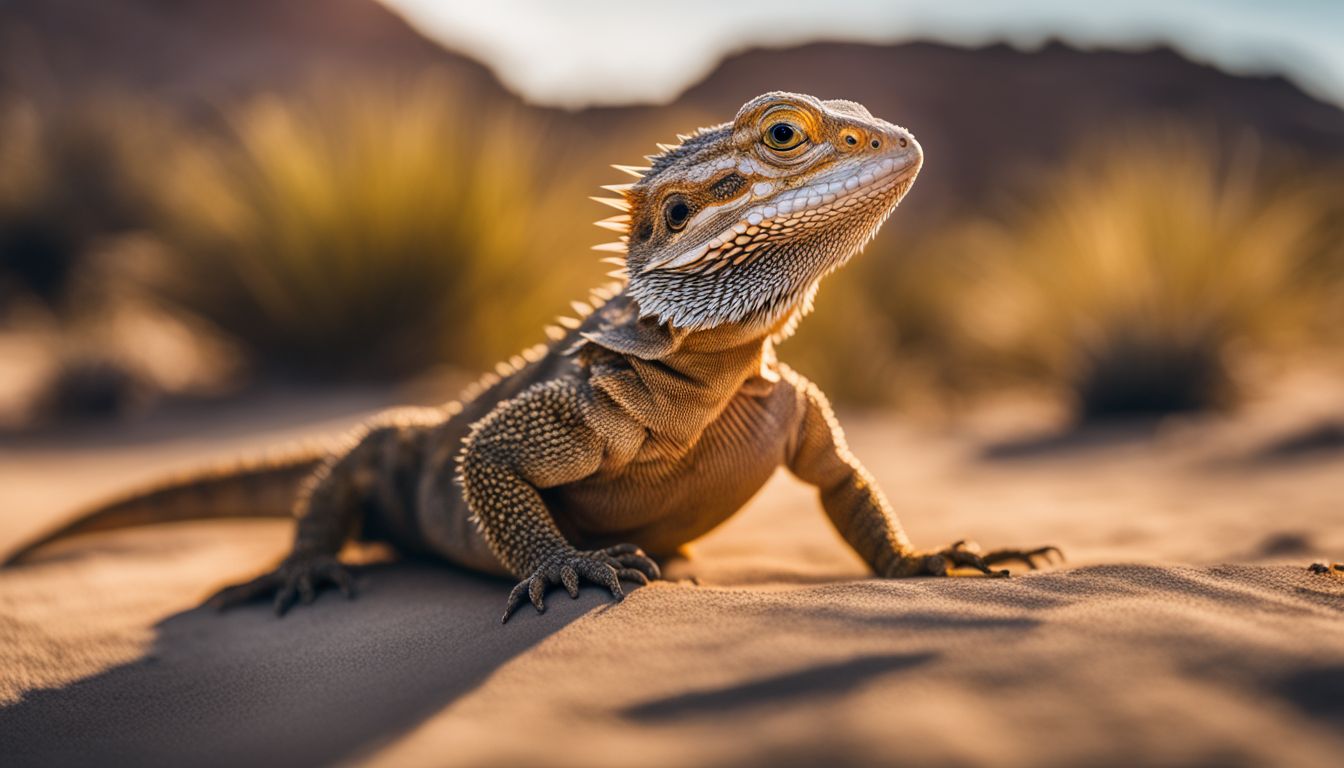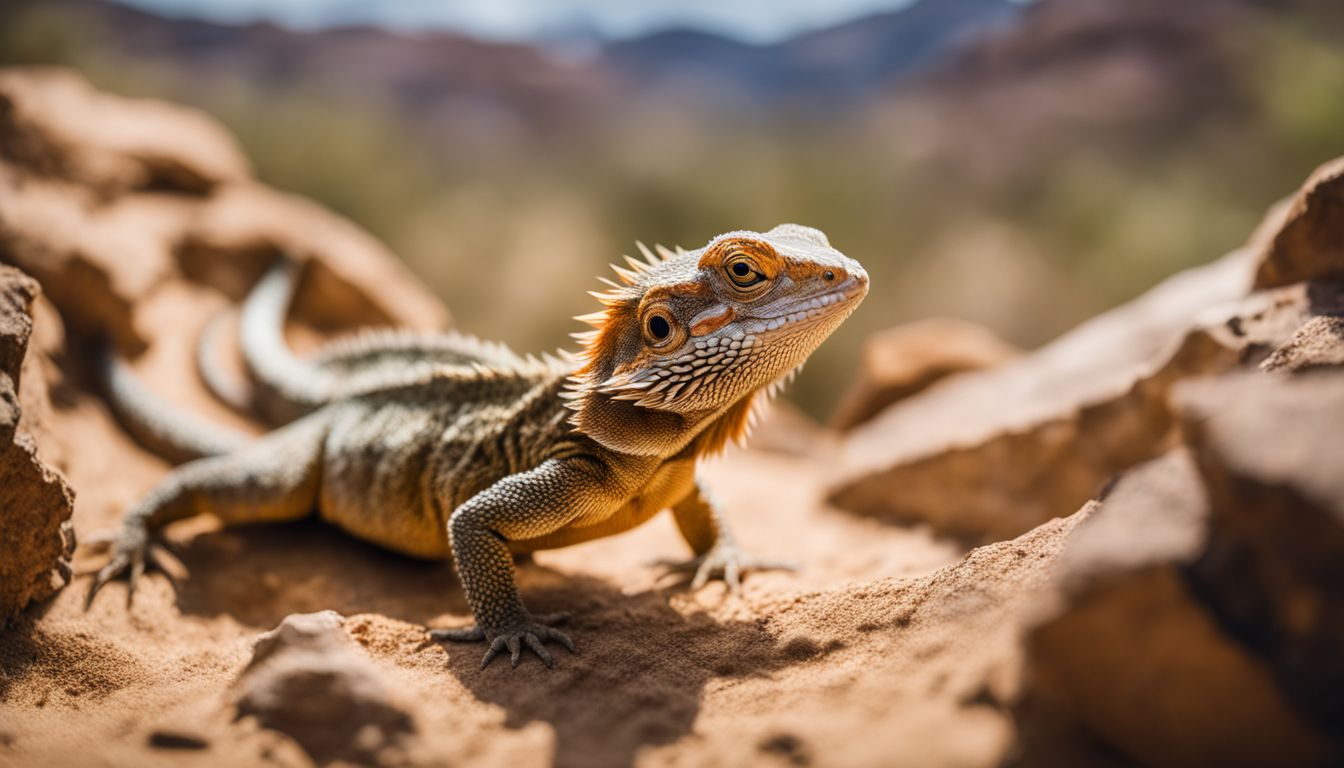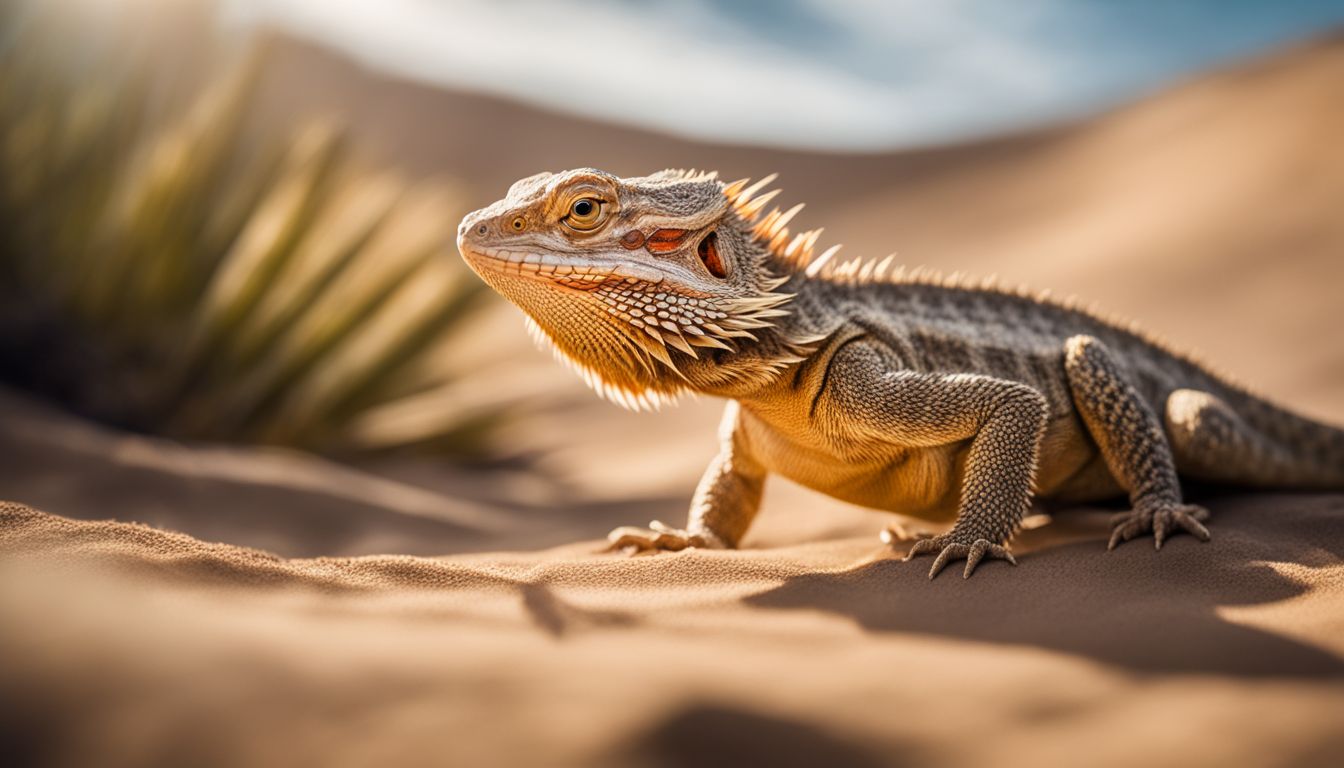Is your bearded dragon darting around their tank like they’re on a mission? It’s noteworthy that bearded dragons can run up to 9 mph. Our guide dives into why this happens and offers solutions to calm your scaly friend.
Stay tuned for expert advice.
Understanding Bearded Dragon Behavior

Bearded dragon behavior includes unique actions like the wave, head bob, and beard puff. They also display color changes, glass surfing, and digging as part of their natural behaviors.
The Wave
Bearded dragons wave their arms as a unique way of saying hello. It’s like they’re signaling, “I see you, but I’m not a threat.” This arm movement isn’t just random; it’s packed with meaning in the reptile world.
Younger dragons often perform this slow wave to show they’re just babies. They want others to know they are harmless and not looking for trouble.
This gesture is all about communication and social interaction among lizards. When one bearded dragon waves, it might be telling another dragon to keep its distance or acknowledging its presence in a non-aggressive way.
Understanding these territorial displays helps us see how complex and fascinating these creatures really are.
The Head Bob
Lizards communicate in unique ways, and the head bob is a perfect example. This behavior is normal for both pet and wild bearded dragons. They might do it to say hello to their human friends or signal something about their health.
Yes, that’s right – while often just a chat move, head bobbing can sometimes point to an underlying condition needing attention.
Understanding these signals helps owners connect with their scaly pals on a deeper level. It’s like learning another language, where every gesture has meaning. The next sign to decode? The beard puff – another fascinating aspect of reptile body language that keeps the conversation going between you and your bearded dragon.
The Beard Puff
Continuing from the head bob, we move on to another fascinating behavior known as the beard puff. Bearded dragons puff out their beards as a defense mechanism, making themselves appear larger and more intimidating.
This action often comes into play when they feel threatened or excited. Imagine seeing your pet suddenly balloon its throat out—it’s not just for show! The beard display serves multiple purposes including territorial behavior and showing aggression towards potential threats.
Puffing up can also signal other conditions such as shedding, where the loose skin might prompt them to expand their throats to ease discomfort. Moreover, if you notice your dragon darkening its beard or body during a puff-up, pay attention.
It could mean they’re feeling cold, scared, stressed or even ill—all vital signs you need to watch for in reptile communication cues. Observing these indicators helps in understanding stress in bearded dragons and adapting care accordingly.
Color Changes
After understanding the bearded dragon’s beard puff as a display of dominance or submission, it’s essential to comprehend their color changes. Bearded dragons can change color due to various emotional states and environmental stressors, indicating territorial displays, temperature regulation, or social interaction.
These reptiles may alter their color when cold, angry, stressed, ill or threatened; different colors represent distinct emotions and well-being.
Coloration in bearded dragons serves as a visual indicator of their health and emotions, with sudden alterations possibly signaling stress or illness. For instance, dark lines on the body may accompany anger or distress while the whole beard could turn black even when not expanded.
Glass Surfing
Glass surfing is when your bearded dragon constantly runs around and paws at the walls or glass of its enclosure. This behavior indicates stress or boredom, often a result of a small enclosure, environmental stressors, or feeling threatened.
It can lead to injury and exhaustion for your pet.
Addressing the underlying cause is crucial; provide a larger and enriched terrarium, minimize stressors in their environment, and offer mental/physical stimulation. Doing so will help reduce glass surfing and ensure your bearded dragon’s wellbeing.
Digging
Digging is a natural behavior for bearded dragons. They are more fulfilled when they have a dig box in their tank. This activity mimics their instinctual burrowing behavior and provides mental stimulation.
By creating an environment that supports digging, you can help your bearded dragon exhibit natural behaviors and stay mentally engaged.
Understanding this natural behavior can lead to better care for your pet reptile. With the right setup, you can create a conducive environment that allows them to express their innate digging instincts while staying healthy and happy.
Brumation
After understanding the behavior of bearded dragons, it’s important to acknowledge their natural tendencies during colder months. Brumation is a period of dormancy similar to hibernation that cold-blooded animals like bearded dragons undergo in response to seasonal changes.
This biological rhythm causes them to become less active, eat less, and sleep more as their metabolism slows down. It’s crucial for pet owners to recognize this natural behavior and ensure they provide the necessary conditions for their bearded dragon to safely navigate through brumation.
During brumation, reptiles become less energetic and may spend prolonged periods resting or sleeping. The decrease in activity levels helps them conserve energy while experiencing the physiological changes associated with this dormant state.
Why Is My Bearded Dragon Running Around Like Crazy?

Your bearded dragon might run around frantically due to stress, high temperatures, abnormal behavior patterns or seeking attention; understanding these reasons is crucial for your pet’s well-being.
To learn more about how to identify and address these issues, keep reading..
Stress & Temperature Regulation
Bearded dragons can run around like crazy when they are stressed or trying to regulate their body temperature. Stress in these reptiles can lead to increased running and restlessness, showing the importance of creating a calm and comfortable environment for them.
Abnormal behaviors such as agitated running can signal stress-induced hyperactivity or anxiety, highlighting the need for measures like environmental enrichment and suitable temperature regulation within their habitat.
To understand why bearded dragons exhibit erratic running behavior, it’s crucial to consider how stress and territorial behavior impact their actions. Providing a conducive environment that minimizes potential stressors is essential for maintaining your dragon’s well-being.
Abnormal Behaviour
Transitioning from stress and temperature regulation to abnormal behavior, it’s essential to recognize signs of unusual behavior in your bearded dragon. When a bearded dragon runs around like crazy, displays erratic movements, or exhibits excessive activity levels, it could indicate underlying issues such as abnormal stress or environmental discomfort.
Unusual behaviors in bearded dragons might also include frantic pawing at the enclosure, which can signal boredom or heightened stress levels. It is crucial to observe these aberrant behaviors carefully as they may point towards parasitic irritation, reptile health concerns, or behavioral issues that require attention and intervention to ensure the well-being of your pet.
Keep an eye out for these symptoms as they may provide valuable insights into your bearded dragon’s health and happiness.
Unusual behavior
Reptile health
Environmental stress
Seeking Attention
When your bearded dragon is running around like crazy, it could be seeking attention. They might display this behavior to get you to notice them or interact with them more. If they feel lonely or bored, they may try to catch your eye by dashing around their enclosure and being extra active.
Providing some extra playtime or handling can often help address this attention-seeking behavior.
Stress and boredom can lead to your bearded dragon acting out in strange ways, including running around like crazy. Noticing the signs of stress and taking steps to enrich their environment can help reduce their need for attention-seeking behaviors.
How to Calm a Bearded Dragon
To calm a bearded dragon:
- Approach your bearded dragon calmly and support their body properly when picking them up to help them feel secure.
- Create a calm and comfortable environment for your bearded dragon to minimize stress.
- Provide enough exercise to prevent excessive running around.
- Recognize signs of stress in your pet lizard and take steps to address it promptly.
Understanding and Responding to Glass Surfing
What is Glass Surfing in Bearded Dragons? It’s a sign of stress and can be managed with environmental adjustments and enriching activities.
What Is Glass Surfing in Bearded Dragons?
While observing your bearded dragon, you might notice them repeatedly sliding or scratching against the walls of their terrarium. This behavior is known as glass surfing. It is a common sign of stress or boredom in bearded dragons and can indicate an underlying issue that needs to be addressed for their well-being.
One key factor contributing to glass surfing is the need for mental stimulation and environmental enrichment.
Bearded dragons engage in glass surfing when they feel restless, stressed, or bored within their environment. This behavior can occur when there are inadequate sources of mental stimulation or if they are experiencing stress due to factors such as improper temperature regulation or lack of hiding spots in their terrarium.
Why Do Bearded Dragons Glass Surf?
Now, let’s delve into the question of why bearded dragons engage in glass surfing. This behavior typically occurs when they see their reflections and mistake them for other dragons or threats.
Additionally, improper positioning of lighting can create reflective surfaces within the enclosure, further triggering this behavior. These environmental stressors can lead to discomfort and confusion for your pet, causing them to run around erratically against the glass walls in an attempt to escape or confront these perceived threats.
Stress indicators such as small enclosures, lack of environmental enrichment, and uncomfortable temperatures can also contribute to this behavior. In order to address glass surfing, it is crucial to understand these underlying causes and provide a suitable habitat that minimizes stress while maximizing behavioral enrichment for your beloved beardie.
How to Stop Glass Surfing
If your bearded dragon is glass surfing, it may indicate stress or a need for more attention and interaction. Here are some steps you can take to help stop this behavior:
- Ensure a Proper Environment
- Provide a spacious and enriching enclosure with hiding spots and climbing structures.
- Maintain proper temperature and humidity levels in the terrarium.
- Daily Interaction and Stimulation
- Spend quality time with your bearded dragon each day, offering gentle handling and supervised exploration outside the enclosure.
- Introduce stimulating activities such as providing different textures for them to walk on or placing safe objects for them to investigate.
- Establish Routine
- Create a predictable daily routine for feeding, handling, and playtime to reduce stress and anxiety.
- Offer Mental Stimulation
- Incorporate environmental enrichment such as moving decorations around or introducing new objects or toys into their habitat.
- Monitor Stress Triggers
- Identify potential stressors in the environment and work to minimize them, such as loud noises or sudden movements.
- Seek Veterinary Advice
- If glass surfing persists despite environmental enrichment, consult a reptile veterinarian to rule out any underlying health issues.
Conclusion
In conclusion, when your bearded dragon is running around like crazy, it may signal stress or the need for mental stimulation. Keep an eye out for abnormal behavior, and ensure their enclosure meets their needs.
Providing a comfortable environment and interaction can help calm your energetic pet. Watch for signs of stress and consult a reptile veterinarian if needed.
For more information on how to provide a nutritious diet for your energetic friend, check out our guide on bearded dragon salad dressing.
FAQs
1. Why is my bearded dragon running around like crazy?
Bearded dragons may run around energetically due to their natural behavior, exercise needs, or seeking attention.
2. Is it normal for a bearded dragon to act hyperactive?
Yes, occasional bursts of activity and energy are normal for bearded dragons and can indicate good health and vitality.
3. How can I calm down my hyperactive bearded dragon?
Create a comfortable habitat with appropriate temperature, lighting, and hiding spots. Limit handling during periods of high activity.
4. Should I be concerned if my bearded dragon is constantly active?
Continuous high activity levels could signal stress or discomfort; ensure the environment meets their needs and consult a reptile veterinarian if concerns persist.
5. Can diet affect a bearded dragon’s activity level?
Yes, an improper diet or feeding schedule can impact behavior; ensure they receive balanced nutrition suitable for their age and size.




